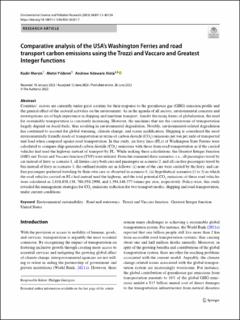| dc.description.abstract | Countries’ sectors are currently under great scrutiny for their response to the greenhouse gas (GHG) emission profle and the general efect of the sectoral activities on the environment. As in the agenda of all sectors, environmental concerns and investigations are of high importance in shipping and maritime transport. Amidst the rising forms of globalization, the need for sustainable transportation is constantly increasing. However, the machines that are the cornerstone of transportation largely depend on fossil fuels, thus resulting in environmental degradation. Notably, environmental-related degradation
has continued to account for global warming, climate change, and ocean acidifcation. Shipping is considered the most environmentally friendly mode of transportation in terms of carbon dioxide (CO2) emissions per ton per mile of transported unit load when compared against road transportation. In this study, six ferry lines (FLs) of Washington State Ferries were calculated to compare ship-generated carbon dioxide (CO2) emissions with those from road transportation as if the carried vehicles had used the highway instead of transport by FL. While making these calculations, the Greatest Integer function (GIF) and Trozzi and Vaccaro function (TVF) were utilized. From the examined three scenarios, i.e., all passengers travel by car instead of ferry as scenario 1, all ferries carry both cars and passengers as scenario 2, and all car-free passengers travel by bus instead of ferry as scenario 3, the outlined results are as follows: (i) none of the cars were carried by the ferry, and car free passengers preferred traveling by their own cars as observed in scenario 1; (ii) hypothetical scenarios (1 to 3) in which the road vehicles carried on FLs had instead used the highway, and the total potential CO2 emissions of these road vehicles
were calculated as 2,638,858.138, 704,958.2998, and 1,394,148.577 tonnes per year, respectively. Policy-wise, this study revealed the management strategies for CO2 emissions reduction for two transport modes, shipping and road transportation, under current conditions. | en_US |

